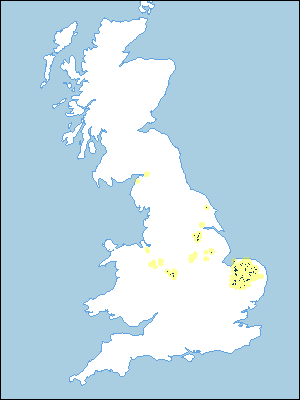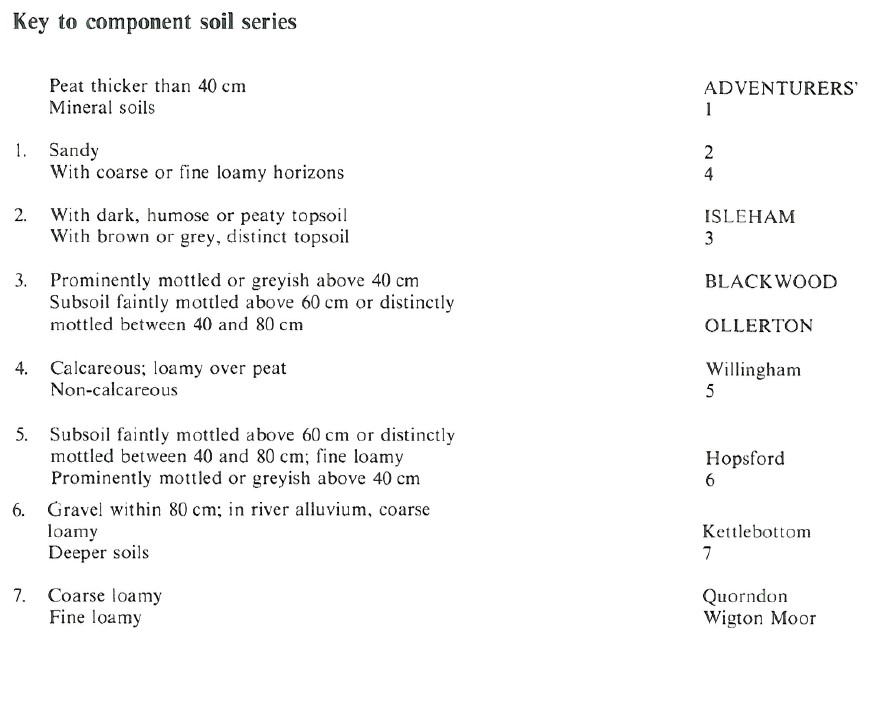
Soil Associations
0861b Isleham 2
Soil and site characteristics
Deep permeable sandy and peaty soils affected by groundwater. Very complex soil pattern with hummock and hollow microrelief locally. Risk of winter flooding. Risk of wind erosion.
Geology
Glaciofluvial drift and peat
Cropping and Land Use
Cereals, sugar beet, potatoes and horticultural crops; rough grazing where undrained.
Component soil series
| Subgroup | Series name | Percentage | WRB 2006 link |
|---|---|---|---|
| 8.61 | ISLEHAM | 31% | Arenic Mollic Gleysols |
| 10.24 | ADVENTURERS' | 29% | Drainic Rheic Sapric Histosols |
| 5.52 | OLLERTON | 20% | Eutric Endogleyic Arenosols |
| 8.21 | BLACKWOOD | 20% | Arenic Mollic Gleysols |
Covers 524 km2 in England and Wales
Soilscapes Classification
| 23 |
Loamy and sandy soils with naturally high groundwater and a peaty surface |
0861b Isleham 2
Detailed Description
The Isleham association consists of sandy and peaty soils on low-lying land affected by groundwater. The soils are formed in glaciofluvial sands covered in places by thin remnants of wasted peat. The association covers 537 km², mainly in Norfolk, Suffolk and Cambridgeshire but it is also scattered widely in the Midlands and Northern England. The distribution of component soils varies from place to place but there is frequently a sequence from sandy soils on slightly raised ground to peats in the lowest positions. The most common soil, the Isleham series, belongs to the typical humic sandy gley soils and has a dark humose or peaty topsoil and a pale grey subsurface horizon becoming brown and mottled below. The Blackwood series, typical sandy gley soils, is not humose but is mottled grey beneath the topsoil. The associated Ollerton series, a member of the gleyic brown sands, has brown mottled profiles. These soils may be slightly stony and Blackwood and Ollerton soils usually occur on relatively high ground. The earthy eutro-amorphous peat soils of the Adventurers' series are generally less than a metre thick. Loamy and clayey soils also occur, the most widely distributed Quorndon series.
There are 424 km² in Eastern England of which 345 km² are in Norfolk, often in strips along the wider valleys. On the margins of the Fens and in the valleys draining to them from the Breckland the glaciofluvial sands often have a characteristic hummock and hollow microrelief, locally called "hills and holes", probably formed by periglacial activity. Here, irregular, sometimes relatively steep-sided mounds or sinuous ridges rise up to 2 m above enclosed depressions which are often 50 m or more across and contain peat up to 2 m thick. Blackwood, Ollerton, or Isleham soils occur on the flanks and crests with Isleham series or Adventurers' soils in the hollows . In the Fens, especially Mildenhall and Hockwold Fens, there were once pools in many of the hollows where shell marl accumulated giving highly calcareous Brimpton and Willingham soils together with soils similar to Isleham series but with calcareous upper layers. The often stoneless sand blows easily and many hollows have been completely filled, but their sites can be identified by augering. Hummock and hollow microrelief is also found in the valleys of the upper Wensum and its tributaries. Ironstone, locally known as ironhard, and probably formed in a similar fashion to bog iron ore, occurs in places at the fen margins. Near Hilgay it can form a persistent layer at shallow depth, and between Hilgay and Sandringham and in Mildenhall Fen it occurs as massive lumps. Between Hilgay and Sandringham, away from the streams, Blackwood and 011erton series are more extensive than Isleham and Adventurers' soils. Along the Little Ouse and Wissey the soils form a characteristic sequence across the valleys, ranging downslope through Ollerton, Blackwood and Isleham to Adventurers' series. But elsewhere in Norfolk, in catchments draining chalky till, there are many additional soils and no discernible pattern. These include Quorndon, Hopsford, Wigton Moor, and Kettlebottom series. There are similar but calcareous soils where the catchments drain the Chalk.
In Humberside and South Yorkshire the association covers 41 km² mainly on flat land to the west and north-west of the Isle of Axholme. Lying close to tidal or formerly tidal rivers, some areas have a surface addition of marine alluvium deposited either naturally or by warping. Here the Everton series is found, consisting of up to 50 cm of sandy clay loam over sand. Blackwood soils in this area are sometimes stony. North of the Humber, on either side of the river Foulness, some stoneless Gilberdyke soils formed in windblown fine sand are included. There are small areas in the upper Derwent valley near Scarborough and in Cumbria on flat to gently undulating land south of Longtown, where Blackwood and Isleham series are the main soils. Adventurers' soils are absent.
Soil Water Regime
The main soils are permeable and the soil water regimes depend on the extent to which the naturally high groundwater level can be lowered. In the Fens, groundwater levels are kept low by pump drainage and the soils are well-drained (Wetness Class I). Elsewhere they are of variable wetness because drainage is by gravity through ditches, the effectiveness of which depends on a clear main outfall. Undrained, Ollerton series is seasonally waterlogged (Wetness Class III), Adventurers' series is waterlogged for most of the time (Wetness Class VI) and Blackwood and Isleham series are between these extremes. The water retentiveness of these-soils depends largely on their organic matter content. Where the peaty Adventurers' soils are well drained, crops do not suffer from drought even in the dry Fenland climate whereas Ollerton series, with a low organic matter content in the topsoil, is moderately droughty for most crops and very droughty for grass. Isleham and Blackwood soils are intermediate in character. There are marked variations in the response of crops where the water-table is at shallow depth in Adventurers' soils but beyond the reach of plant roots under Ollerton soils on adjacent hummock crests.
Cropping and Land Use
The main soils are easily worked and, where effectively drained, there are excellent opportunities for landwork both in autumn and spring, the sandy soils in particular being accessible a day or two after rain even in winter. Locally the presence of microrelief makes the timing of cultivations complicated because soils in the hollows remain wet when those on the ridges are ready to work. Yields are variable and, on well drained sites, are low on Ollerton series but higher on Adventurers' soils. Locally therefore, the land is not considered good agriculturally but it is cropped for cereals, sugar beet and some rye. Wind erosion is a hazard on cultivated land. In river valleys that are not easily drained, as in much of Norfolk, the association is grassland or rough meadowland, with scrub in places, and here poaching severely restricts grazing. Field vegetables, especially carrots and red beet, are grown on land adjacent to the Isle of Axholme. Near Scarborough the soils are in general cropping but the greater rainfall, although reducing the risk of summer drought, leaves fewer days suitable for landwork in winter. In Cumbria the land is mainly under permanent grass and mixed woodland.
0861b Isleham 2
Distribution Map
 |
Note that the yellow shading represents a buffer to highlight the location of very small areas of the association.
Keys to component soil series
Eastern Region
 |
Northern Region
 |
Typical Landscapes
Eastern Region
 |
Eastern Region
 |
All information Copyright, Cranfield University © 2025
Citation: To use information from this web resource in your work, please cite this as follows:
Cranfield University 2025. The Soils Guide. Available: www.landis.org.uk. Cranfield University, UK. Last accessed 25/04/2025
